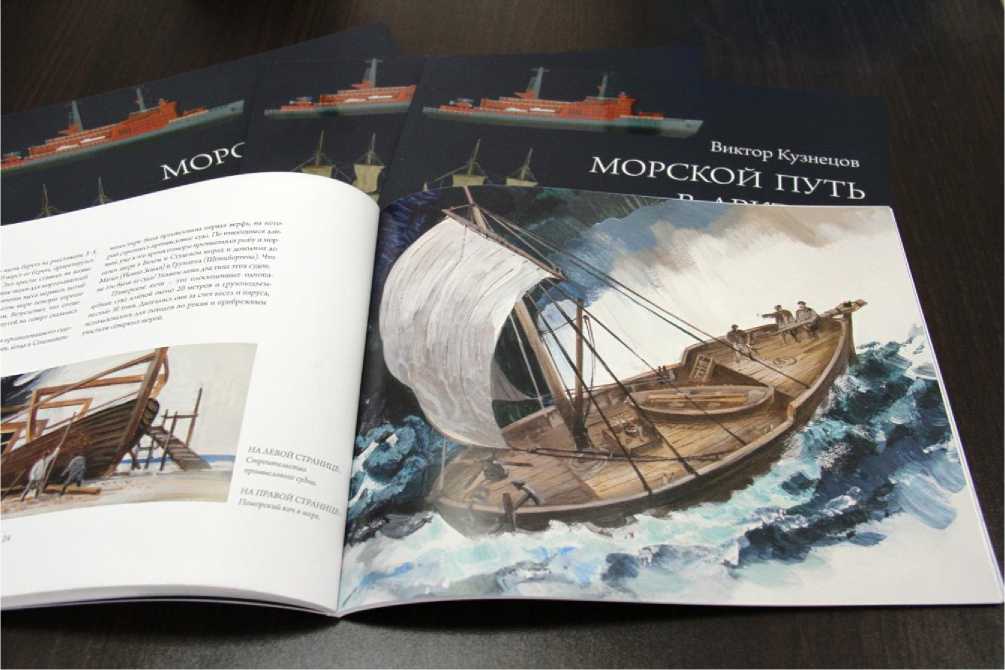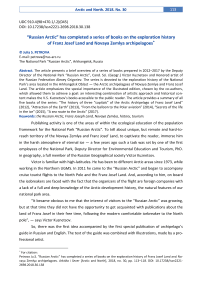“Russian Arctic” has completed a series of books on the exploration history of Franz Josef Land and Novaya Zemlya archipelagoes
Автор: Julia S. Petrova
Журнал: Arctic and North @arctic-and-north
Рубрика: Reviews and reports
Статья в выпуске: 30, 2018 года.
Бесплатный доступ
The article presents a brief overview of a series of books prepared in 2012–2017 by the Deputy Director of the National Park “Russian Arctic”, Cand. Sci. (Geogr.) Victor Kuznetsov and Honored artist of the Russian Federation Alexey Grigoriev. The series is devoted to the exploration history of the National Park’s area located in the Arkhangelsk Oblast — the Arctic archipelagoes of Novaya Zemlya and Franz Josef Land. The article emphasizes the special importance of the illustrated edition, chosen by the co-authors, which allowed them to achieve a goal: an interesting combination of artistic approach and historical content makes the V.S. Kuznetsov’s books accessible to the public reader. The article provides a summary of all five books of the series: “The history of three “capitals” of the Arctic Archipelago of Franz Josef Land” (2012), “Attraction of the Earth” (2013), “From the balloon to the Polar aviation” (2014), “Secrets of the life in the ice” (2015), “A sea route to the Arctic” (2017).
The Russian Arctic, Franz-Joseph Land, Novaya Zemlya, history, tourism
Короткий адрес: https://sciup.org/148318552
IDR: 148318552 | УДК: 910.4(98+470.1/.2)(045) | DOI: 10.17238/issn2221-2698.2018.30.138
Текст научной статьи “Russian Arctic” has completed a series of books on the exploration history of Franz Josef Land and Novaya Zemlya archipelagoes
Publishing activity is one of the areas of within the ecological education of the population framework for the National Park “Russian Arctic”. To tell about unique, but remote and hard-to-reach territory of the Novaya Zemlya and Franz Josef Land, to captivate the reader, immerse him in the harsh atmosphere of eternal ice — a few years ago such a task was set by one of the first employees of the National Park, Deputy Director for Environmental Education and Tourism, PhD. in geography, a full member of the Russian Geographical society Victor Kuznetsov.
Victor is familiar with high-latitudes. He has been to different Arctic areas since 1973, while working in the Northern UGMS. In 2011 he came to the “Russian Arctic” and began to accompany cruise tourist flights to the North Pole and the Franz Josef Land. And, according to him, on board the icebreakers are faced with the fact that the organizers of the flight are foreign companies with a lack of a full and deep knowledge of the Arctic development history, the natural features of our national park area.
“It became obvious to me that the interest of visitors to the “Russian Arctic” was growing, but at that time they did not have the opportunity to get acquainted with publications about the land of Franz Josef in their free time, following the modern comfortable icebreaker to the North pole”, — says Victor Kuznetsov.
So, there was the first idea accompanied by the first special publication of archipelago’s guide in Russian and English. The text of the guide was combined with Illustrations, made by a professional artist.
∗ For citation:
When creating the guide, the author had a genuine interest in various historical events that took place at different time in the Arctic and on the France-Joseph Land in particular. “On the Islands, the construction of the pioneers and ruins of the first Arctic winters are preserved, we study and show visitors the traces of the expeditions field bases left by enthusiasts who tried to conquer the North. Field work in the group of state inspectors, who accompanied the cruise ships, inspired to write a book on the history of the three “capitals” of the Franz-Joseph Land archipelago", — says Kuznetsov.
The idea to accompany the text with colorful illustrations was supported by the Honored artist of the Russian Federation Alexey Grigoriev — a person who is passionate about the Arctic, its nature and history. The first book of the creative tandem tells about three meaningful places of Franz Josef Land: the base of the British researcher Frederick Jackson on Cape Flora of the Northbrook Island (1894–1897), the Soviet polar station of the Tikhaya Bay on the Hooker island (1929– 1959) and the largest in the entire Russian Arctic scientific Observatory “Druzhnaya” on the Hayes island, opened in 1957.
Why were these three “capitals” chosen? Every chosen settlement has its own peculiarities and characteristics, historic events behind and people. E.g., the Jackson expedition had a lot of scientists. They made the first research in meteorology, terrestrial magnetism, geology, botanic, zoology and hydrobiology on the Islands of the central part of Franz Josef Land. The obtained results made it possible to write a general description of the natural conditions of the archipelago.
The first Soviet polar station in the Arctic, the Tikhaya Bay, became the basis for securing the Franz Josef Land as the territory of the Arkhangelsk Oblast. Here, for the first time, studies of the Arctic atmosphere were made and the instruments for measuring the parameters of its individual layers were tested. Here the study of glaciers began.
And on the Hayes island almost started the space age. There the first meteorological rocket was launched. Methods of rocket sounding of the atmosphere were worked out in the Observatory “Druzhnaya”, as well as the registration of all components of an electromagnetic field of the Earth began. The number of employees of the Observatory sometimes reached 200 people, and there was opened the northernmost kindergarten in the country.
The first book of a series on the “Russian Arctic” was called “The History of the Three “Capitals” of the Arctic Archipelago Franz Josef Land”; it was published in 2012.
That time, the territory of the National Park was only the Northern part of the archipelago of Novaya Zemlya and adjacent small Islands. Franz Josef Land was a reserve of Federal significance and was managed by the National Park. “Therefore, we couldn’t ignore the Novaya Zemlya”, — said Viktor Kuznetsov. — “And decided to continue cooperation with Alexey Semenovich and began work on the book which was called “Attraction of the Earth”.
The publication is a retrospective of the major historical events on the Novaya Zemlya from the Willem Barents’s wintering in the Ice Harbor and until the establishment of the National Park “Russian Arctic” in 2009. The book includes sections devoted to the development of the Novaya
Zemlya by the Pomors and the Russian expeditions 17th — 19th centuries, researchers V.A. Rusanov and G.Ya. Sedov. It also contains a description of the works completed by the employees of the National Park before the publication of the book in December 2013.
“Working on this book in collaboration with Alexei Grigoriev, I’ve realized that decoration requires a special attention. And here is why”, — recalled Viktor Kuznetsov. — “Our publications are aimed at the mass reader, incl. the cruise tourists, and therefore it should not only give objective information about the events, but also vividly, the spirit, and the mood of the participants of these events. Therefore, it was decided to publish the second book of the cycle, and all subsequent ones in the Severodvinsk printing house, whose specialists have extensive professional experience in decorating printed publications. And I am especially grateful to Alexey Semenovich that he was able to visualize all my ideas in his graphics.”
Interesting combination of artistic approach and historical content, marked by the first readers, was decided use in the future publications. More, the idea for next books was hovered in the air. And less than a year later, in October 2014, the Visit center of the National Park hosted the presentation of the next book “From the Balloon to Polar Aviation”. That time the centenary of the first Arctic flights of the Russian pilot Jan Nagursky was celebrated. He made flights on the plane “Farman MF-11” near Novaya Zemlya with an open cockpit. This date inspired Victor Kuznetsov, because he is sure: without polar aviation in high latitudes it is impossible to work! “The development of vast Arctic areas is difficult to imagine without the aircraft. It was understood by pioneers and it is understood by us now. The history of Arctic exploration and aviation history are inextricably linked. In 1914, Yan Nagursky made his first flights in the Arctic near Novaya Zemlya. His task was to find the missing Russian expeditions of Rusanov and Brusilov. Traces of the pilot were not found, but today his name is immortalized in the name of the frontier on the island of Alexandra Land, there is an airfield. The area is now the territory of the Arkhangelsk Oblast, and it is important for us to remember this”, — says Viktor Sergeevich.
The Arctic is an element. In this element, the main place is occupied by ice and wind. The sea surface is covered with drifting ice in constant motion. Glaciers occupy 85% of Franz Josef land and 60% of the North of Novaya Zemlya. Glaciers on the Islands are also in slow motion. They are going down into the sea and give birth to icebergs. An unexpected meeting of the ship with the iceberg threatens. People in the Arctic are constantly faced with ice and glaciers. The main life stories tell about the struggle of a man with the ice and its use are reflected in the next book “Secrets of the life in the ice” (2015).
The book “A Sea Route to the Arctic” concludes a series of five illustrated editions about the “Russian Arctic” created by the creative tandem. The book saw the light at the end of 2017, and it was presented to the public in the framework of the “Days of the Arctic” at the Intelligence Center of the NArFU. The book is devoted to the history of navigation and its role in the development of the Arctic region.
“This topic seems to be particularly interesting for a tourist who is on a modern comfortable ship goes to the Arctic islands only for a few hours, and then returns to the comfortable conditions of the modern world”, — the author reflects. — “Of course, a person is interested in the development of the world navigation, natural and human forces used to move the ship on the water and how the human mind reached the possibility of using nuclear power plants on ships. After all, it is the atomic icebreaker that the tourist gets to the North Pole today”.
The section devoted to the role of Arkhangelsk in the development of the Arctic navigation became the undoubted decoration of the book.
We add that this is the final edition, and all previous ones could be found in the libraries of the town and oblast. Several times these books became finalists and winners of the regional contest “Book of the year”.

Fig. 1. Kuznetsov at the presentation of the book “A Sea Route to the Arctic”. Photo: Julia Petrova
Flipping through books by Viktor Kuznetsov, one will be amazed by how accurately the author managed to pass on the characters of people who mastered the Arctic spaces and went on a feat for the good of the Fatherland, their incredible courage and fortitude. Indeed, in modern life, we sometimes do not have enough of these romantic impulses and emotions that moved people of past epochs who declared themselves on the Arctic expanses.
Information on illustrated editions of the “Russian Arctic”, prepared in the series:
“The History of the Three “Capitals” of the Arctic Franz Josef Land Archipelago” . Archan-gelsk, 2012. 32 p.: ill. Circulation 500 copies.
Content:
-
• Cape Flora
-
• Tikhaya Bay
-
• Hayes Island
“The Attraction of the Earth” . Arkhangelsk, 2013. 40p.: ill. Circulation 500 copies.
Content:
-
• Foreword
-
• Pioneers
-
• Russian expeditions
-
• The role of V.A. Rusanov and G.Ya. Sedov in the development of Novaya Zemlya
-
• Briefly about the Soviet period
-
• Beginning of work of the national park “Russian Arctic”
“From the Balloon to the Polar Aviation” . Arkhangelsk, 2014.52 p.: ill. Circulation 500 copies.
Content:
-
• History of aeronautics and the origin of aviation
-
• The first attempts to use the balloon to reach the North Pole
-
• The flights of Jan Nagursky
-
• Amundsen and its transarctic flights
-
• Expedition on the airship “Italy”
-
• Expedition on the airship “Graf Zeppelin”
-
• The first scientific station on the North Pole
-
• Polar aviation
“Secrets of the life in ice” . Arkhangelsk, 2015. 60 p.: color. ill. Circulation 500 copies.
Content:
-
• Mysterious ice
-
• Ice floe passengers
-
• Lee Smith: the first building
-
• Jackson and Nansen: the beginning of amazing meetings
-
• American expeditions: the foothold of the North Pole conquerors
-
• The Italian expedition: the first losses in the drifting ice
-
• V. Albanov: will, endurance and perseverance are the key to success
-
• George Sedov: the human factor
-
• Rescue search expeditions: a difficult search path and long-awaited findings
-
“ A Sea Route to the Arctic” . Arkhangelsk, 2017. 48 p.: color. ill. Circulation 500 copies.
Content:
-
• The beginning of navigation
-
• Opening of polar regions
-
• About the role of Arkhangelsk in the development of the Arctic navigation
-
• Principles of movement
-
• Science and technology

Fig. 2. Kuznetsov’s V. books illustrated by A. Grigoriev. Photo: Julia Petrova

Fig. 3. Pages of the book “A Sea Route to the Arctic”. Photo: Julia Petrova


